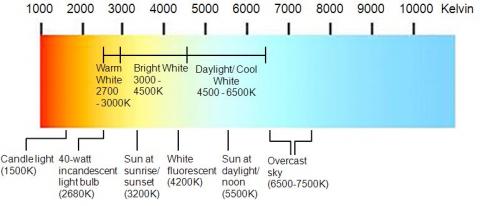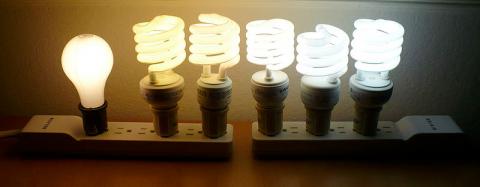
Put simply, color temperature is the color of light that comes out of a light bulb. It is given on the product packaging as a number with the units of Kelvin, K. The lower the number, the more red or orange (usually defined as warm) the light appears and the higher the number the bluer the light appears (usually defined as cool).
The image below comes from a color temperature comparison of an incandescent and several CFLs from Wikimedia.

"From left to right: 100 watt soft white incandescent, 2700K CFL, 3500K CFL, 4100K CFL, 5500K CFL, 6500K CFL. All CFLs are 100 watt replacements, ranging from 23 to 26 watts."
Why is the number represented by Kelvin? Good question.
The best definition we've found on why we use Kelvin to define color temperature is from 3drender.com.
"This was started in the late 1800s, when the British physicist William Kelvin heated a block of carbon. It glowed in the heat, producing a range of different colors at different temperatures. The black cube first produced a dim red light, increasing to a brighter yellow as the temperature went up, and eventually produced a bright blue-white glow at the highest temperatures. In his honor, Color Temperatures are measured in degrees Kelvin, which are a variation on Centigrade degrees. Instead of starting at the temperature water freezes, the Kelvin scale starts at "absolute zero," which is -273 Centigrade. (Subtract 273 from a Kelvin temperature, and you get the equivalent in Centigrade.) However, the color temperatures attributed to different types of lights are correlated based on visible colors matching a standard black body, and are not the actual temperature at which a filament burns."
Wikipedia addresses the perfect black body radiator on its page on the topic of Color Temperature:
"The color temperature of a light source is the temperature of an ideal black body radiator that radiates light of comparable hue to that of the light source. In practice, color temperature is only meaningful for light sources that do in fact correspond somewhat closely to the radiation of some black body, i.e. those on a line from reddish/orange via yellow and more or less white to blueish white; it does not make sense to speak of the color temperature of e.g. a green or a purple light. Color temperature is conventionally stated in the unit of absolute temperature, the kelvin, having the unit symbol K."

Post new comment